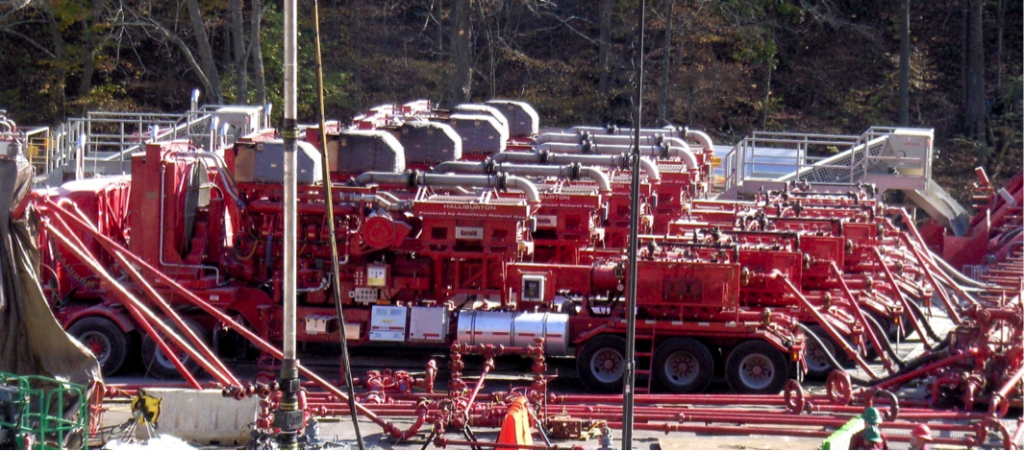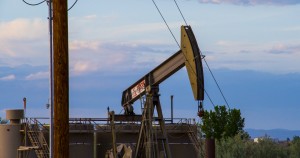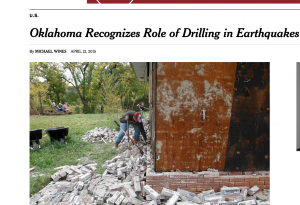Frackquake Madness! — 35 Fracking Earthquakes Rock Oklahoma in a Week — Regulators Call Event a ‘Game Changer’

(EnviroNews World News) — Oklahoma City, Oklahoma — Historically speaking, Oklahoma used to be a place where almost no palpable earthquakes happened at all — but hydraulic fracturing, a.k.a. “fracking” has changed all that now.
Between the dates June 17 and June 24, 2015, Oklahoma was jolted by 35 earthquakes greater than magnitude 3.0 due to fracking and fracking wastewater injection activities, the Oklahoma Geological Survey (OGS) has confirmed — this, in a state that experienced less than two such quakes per year before 2009.
The sketchy episode comes only two months on the heels of the implementation of new regulations in the state that prevent operators and waste disposers from injecting wastewater “below the state’s deepest rock formation, believed to be one of the main causes of the quakes,” Reuters reported.
The Oklahoma Corporation Commission (OCC) regulates all oil and gas activities in the state, and had a strong and vocal response to last week’s unprecedented episode.
Matt Skinner, a spokesman for the OCC told Reuters, “There’s been a huge increase. That’s a game-changer,” insinuating that OCC may need to implement even more rules in an effort to deescalate the frequency and force of the tremors — a shaky situation that has many residents in Oklahoma downright concerned.
Homes have been rattled and damaged to the tune of tens of thousands of dollars, and worrying regulators is the stark fact that some of last week’s quakes stretched beyond rural oilfield areas and shook homes and businesses along fault-lines in metropolitan, and heavily populated Oklahoma City.
OKLAHOMA’S MANMADE, INDUSTRY-CREATED, SEISMIC DEBACLE
To be clear, the activity of fracking, or basically blowing up rocks underground to release oil and gas, in and of itself can and does cause earthquakes. However, it is the underground injection of fracking flow-back water, or wastewater that is blamed for most of the simply massive increase in earthquakes in Oklahoma.
When briny, chemically-loaded fracking flow-back water is pumped back underground it has a tendency to perniciously pressurize the geological formations, causing things to slip, shift or give way. In Oklahoma, the problem has become chronic.
Decades upon decades of exploitation have left Oklahoma’s oilfields saturated with water, and the sheer volume of wastewater injection wells is making it very difficult for experts and regulators to zero out culprit wells that might be upsetting faults.
In a section titled, WATER-LOGGED OIL FIELDS, Reuters reporter Yeganeh Torbati, in her article on the subject, wrote:
To be sure, Oklahoma faces a different set of challenges from other states. It is crisscrossed with fault lines, many of which were unmapped before the quakes began to get notice.
Some of Oklahoma’s most active oil fields are also its most water-logged, such as the Mississippi Lime formation, where drillers recover, on average, more than seven barrels of water for every barrel of oil, according to a study by Kyle Murray, a hydrogeologist at the Oklahoma Geological Survey.
Oklahoma is home to a staggering 3,200 saltwater injection wells — many of which are in areas where the water-to-oil ratio is very poor. Unlike situations in Kansas and other states where particular injection wells have been definitively linked to seismic events, in Oklahoma, the situation is complex, and regulators have had limited, if any success pinning specific wells to corresponding seismic events.

To add fuel to the water-logged fracking fire, “waterflooding“, is yet another “secondary recovery technique” rarely discussed in the media, wherein millions upon millions of gallons of water are pumped underground to re-pressurize entire oilfields that have been deflated to a point of low productivity. Waterfloods have been deployed widely in Oklahoma and are also surely contributing to underground formational movements.
With the escalating and chronic situation in Oklahoma’s watery oilfields, and the strong words coming from OCC regarding last week’s epic series of seismic events, onlookers are wondering what the agency’s next move will be toward cracking down on industry-caused quakes — and if legislation will soon be necessary to get regulators regulating, in a scene that is now reaching crisis levels for citizens and the oil industry alike.
IN LANDMARK ADMISSION, STATE OF OKLAHOMA ACKNOWLEDGES FRACKING THE CULPRIT
Just two months back, on April 21, 2015, “after years of official skepticism,” the Sooner State finally accepted that “billions of barrels of wastewater from oil and gas wells,” were officially to blame for the marked and massive increase in seismic activity, reported the New York Times.

In the past, Texas and Colorado were at the center on the debate surrounding seismic activity from fracking-related activities — but that discussion has now largely shifted to Oklahoma — the primary reason being, historically there have been almost no palpable earthquakes there at all, making it easier to observe the connection between oil and gas plunder and subsequent seismic events.
It’s important to understand this isn’t just a minuscule or questionable increase in seismic activity that is being discussed here. According to state-conducted research, widespread fracking, and fracking wastewater injection have transformed the state from a place that had an average of two tiny earthquakes a year, to the most seismically active area in the United States. In fact, the massive surge in fracking-related quakes has even alerted OGS as to the existence of many formerly stable and dormant underground faults, that it didn’t previously know existed.
EcoWatch reported, “Oklahoma was never big earthquake country, but in the last six years their numbers have surged, going from an average of two a year over 3.0 magnitude to 538 last year, surpassing California as the U.S.’s most seismically active state.”
The state of Oklahoma has even set up its own earthquake website, whereon it states front and center on the homepage, “Oklahoma experienced 585 magnitude 3+ earthquakes in 2014 compared to 109 events recorded in 2013. This rise in seismic events has the attention of scientists, citizens, policymakers, media and industry.”
Those are no small statistics — au contraire — by all accounts, the findings are highly significant to say the least. There is a massive connection going on, and Oklahoma has now at least acknowledged that fact, and has even implemented a new rule in hopes of seeing a reduction in events. But after last week’s upsetting spike, the state has more pressure than ever on it to put a damper on the shaky ground, before things get out of hand.
Oklahoma’s extraordinarily water-saturated oilfields in tandem with the widespread deployment of fracking — blasting underground formations apart and propping them open with sand and deadly chemicals — coupled with widespread waterflooding and 3,200 fracking wastewater disposal wells, have all created the perfect storm — a circumstance that has now generated a manmade, seismically unstable environment — a place haven to bubbling, stewing, emotional unrest, in the correspondingly affected communities.
FRACKQUAKES — AN ESCALATING THREAT NATIONWIDE
Oklahoma isn’t the only place shaking from “frackquakes” these days. In addition to documented areas in Texas, Ohio and Colorado, Alabama, Arkansas, Kansas, and New Mexico have also experienced such tremors according to a report issued by the United States Geological Survey (USGS) in April of 2015.

A study released in January of 2015 showed earthquakes were set off in Ohio by fracking, not wastewater injection, by a number of wells located near fault-lines — and this is only one of multiple reports from around the country.

Hydraulic fracturing activities “built up subterranean pressure and caused slippage in an existing fault that contributed to dozens of mild earthquakes in Poland Township, Ohio,” reported TIME in its article on the study.

The problem is not limited to the United States. “Frackquakes” as they have come to be known, are becoming ever more frequent throughout Canada, Europe and the entire world. Only a couple weeks back, oilfield communities in Alberta, Canada were rattled by two earthquakes and industry regulators and other local experts said that fracking was indeed the culprit in both those cases.
With evidence evermore widely demonstrating that both fracking, and fracking wastewater injection cause earthquakes the question remains: If oil and oil-waste companies are stopped, or greatly reduced, in their ability to pump the boundless billions of gallons of nasty, deadly water associated with production back underground, in an out-of-sight-out-of-mind fashion, what ever will the industry do?
FRACKING TYCOON HAROLD HAMM FAILS IN SHADY FRACKQUAKE COVERUP ATTEMPT
Previous to the Sooner State officially accepting the stark cold reality that oil and gas activities are to blame for the massive uptick in earthquakes, Oklahoma native and multi-billionaire oil and gas tycoon Harold Hamm was busted via records requests by the media, in an attempt to intimidate and gag an OGS researcher, over strong earthquake-fracking connections exposed by his studies.
In a shady backdoor meeting conducted in the office of University of Oklahoma President David Boren, Hamm summoned, and arguably threatened, a state geologist by the name of Austin Holland, wherein Hamm told him he had better “be careful” when publicly discussing the connection he had made between wastewater injection and earthquakes.
Ecowatch reported that following the meeting, which Hamm originally told the geologist was intended for “coffee,” Holland emailed a colleague stating, “It was just a little bit intimidating.”
Shady business by Hamm to say the least, but easy to understand if one considers the potential regulatory and financial threat that authoritative proof of frackquakes could pose to oil drillers and waste operations alike.
As a poster-child of the Midwestern shale boom, Hamm was one of the tycoons hit hardest by the great oil price crash of 2014. He watched his own net worth deflate by roughly 50% virtually overnight — reportedly evaporating from over $18 billion to $9 billion in the course of about a month in September of 2014.

Hamm, the Chairman and CEO of Continental Resources, is also known as the “pioneer of fracking,” and the “founding father of the U.S. fracking boom,” and he and Continental could stand to loose a lot if further regulatory clamps were placed on drilling activities as a result of Holland’s revelations.
Matthew Phillips and Benjamin Elgin of Bloomberg wrote this in their piece:
Holland had been studying possible links between a rise in seismic activity in Oklahoma and the rapid increase in oil and gas production, the state’s largest industry… Hamm requested that Holland be careful when publicly discussing the possible connection between oil and gas operations and a big jump in the number of earthquakes, which geological researchers were increasingly tying to the underground disposal of oil and gas wastewater, a byproduct of the fracking boom that Continental has helped pioneer.
Despite Hamm’s best efforts to stuff, stifle and stymie the truth about how he, and his fellow fracking friends are unequivocally moving and shifting the very earth below Oklahomans’ feet, the truth has prevailed. If you buy into OCC’s tough talk after this past week’s relentless shaky events, it would appear that Oklahoma may be on it’s way toward reigning in the artificial quakes — what that process looks like, both on the regulatory and legislative fronts is unknown at this time.
The frequency at which these events are currently transpiring puts Oklahoma in uncharted waters — watch this space carefully to see if more frackquake episodes continue to rattle its land and people, and if the OCC and the state legislature ramp up to quell the quakes.
OIL CEOs TOLD ENVIRONEWS ABOUT OKLAHOMA FRACKING EARTHQUAKES ON CAMERA YEARS AGO
In late 2012, at an undisclosed location in the Northern hemisphere, I interviewed a sitting, anonymous, whistleblowing oil and gas CEO of over 20 years on camera about the deadly dangers of fracking. At the time, the big U.S. fracking news was centered on Governor Andrew Cuomo of New York who faced a tough decision on weather or not to ban the technique in his state as time ticked away.
In that interview, I addressed Cuomo’s looming decision with the CEO, and his response on that topic was a shocker to many. Within 24 hours of the release of that interview, Cuomo kicked the can down the road yet again on the issue.
North American Oil and Gas CEO Blows the Whistle on #Fracking: “@NYGovCuomo , Please Don’t Do It!” https://t.co/YjYe7v9X
— Yoko Ono (@yokoono) February 13, 2013
Nearly two years later in December of 2014, and after tremendous anticipation, Cuomo apparently decided to heed the advice of the CEO in black, and many many others, as he moved in monumental fashion to effectively ban fracking in New York state through a historic moratorium.
In that same EnviroNews USA segment wherein Cuomo’s decision, groundwater contamination and various other fracking dangers were discussed, the CEO spontaneously jumped over to the topic of Oklahoma in his fracking sermon, and revealed that he was already well aware of the state’s industry-made earthquake problem. (Editor’s Note: The section of the video where the whistleblower discusses Oklahoma fracking earthquakes comes around 5:45 in the video)
Oil & Gas CEO Says Fracking Earthquakes Already Observed in Oklahoma in 2012
The episode with Oilman X as we’ve labeled him, seems to demonstrate that industry knew full well fracking and wastewater injection had already caused quakes in Oklahoma at least as early as 2012 and likely earlier. Why was OCC initially so reluctant to admit the connection?
WHAT’S NEXT FOR OKLAHOMA AND THE SOONER FRACKQUAKE CONUNDRUM?
Multiple correspondents have expressed to EnviroNews over the years, that in their opinion, it may be earthquakes related to fracking, and fracking wastewater injection that ultimately lead to stricter regulations or even bans of the practices — not groundwater, air pollution or other environmental concerns. It would appear, some Republican Oklahoma lawmakers may share in that train of thought.
Jason Murphey (R), representing District 31 in the Oklahoma House of Representatives told Reuters, “If there is damage and loss of life, you will see the political climate absolutely change overnight.” “When and if that happens, you will have a cloud that hangs over the energy sector for the rest of our lives,” Murphey continued.
“If it’s your house that’s shaking, we are moving way too slow and we recognize that,” Michael Teague, Oklahoma’s Secretary of Energy and Environment, told Reuters.
“The best case is we would probably be decreasing in seismicity slowly for awhile… “It wouldn’t shut off the next day,” said Todd Halihan a geologist at Oklahoma State University.
It now appears that residents in many areas of Oklahoma must sit tight and adjust to living not only with tornados that can demolish their dwellings, but also ever-lurking oil and gas quakes that can turn their homes to rubble as well.
FILM AND ARTICLE CREDITS
- Emerson Urry - Journalist, Author



